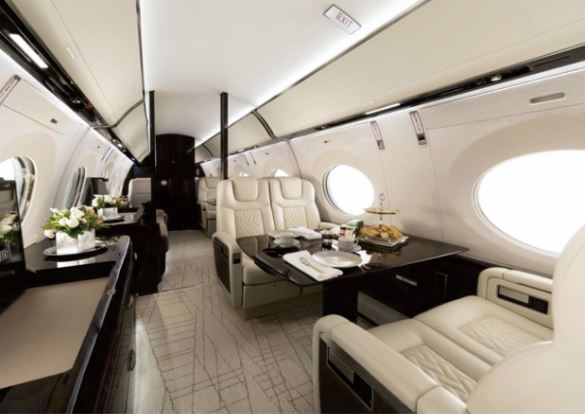I thought I'd post a few pics and talk about the all new Gulfstream G600, which is also confusingly known as a GVII (G7). It's a large cabin, fly-by-wire business jet, about the size of a G550, with a little bigger (fatter) fuselage, Pratt & Whitney 815 engines and loaded with a really nice mix of modern cockpit +cabin features along with the robust, capable Honeywell EFIS.
My first flight was on the "green" airplane, no interior. I simply rode along to make sure there were no glaring engine or air data problems prior to purchase. The second flight was the "cold soak" flight where we spend hours at altitude just to see what goes wrong. The third flight was the delivery flight.
The Pratt engines are interesting, they are a non geared medium bypass turbofan, the bypass ratio is 5.5-5.6, and for those who care, that's a lot of bypass for a high speed business jet easily capable of M0.925 cruise speeds. To get the performance necessary, Pratt uses 2 turbines to drive the core engine and a stunning 5 turbines to drive the non geared fan. As you might expect, takeoff and low altitude performance is stunning. Acceleration is even better than the mighty G550 as is initial climb. Quite simply, it's stupid-fast and you know it. Keep in mind, these are long range aircraft and can (if needed) carry fully half their weight in fuel.
And that's where the "engine tuning" issue comes in. For all it's power, the plane struggles at it's service ceiling, more so than Rolls Royce powered Gulfstream's. Rate of climb nearing FL510 was down into the nil range, and I'm not at all sure the Pratt engines are up for that task. We were shy on speed and climb rate, and AOA (nose up) was well into the yellow. You can see it in the pic from the tail camera. The engine was near no RPM/Temp limits and I'm fairly sure Pratt could "tweak" the software for better high altitude performance.
Down at more reasonable altitudes, this thing's a screamer. Climb speed is solidly M0.87, and man do you cover a lot of ground in climb. As an added bonus, air temp is warmer during climb, and therefore the indicated Mach number results in fantastic airspeed. This thing is faster over the ground during climb than nearly any normal jet aircraft is in cruise! Flat out amazing. Many pilots will note that a higher cruise mach number really does not significantly shorten a 2 hour trip. But they fail to calculate ground covered in a M0.87 climb and a M0.925 descent. FL to NJ this thing saves 20 minutes.
Life at 51,000 feet:

A good view of the cockpit:

And a cool view of the wing:




My first flight was on the "green" airplane, no interior. I simply rode along to make sure there were no glaring engine or air data problems prior to purchase. The second flight was the "cold soak" flight where we spend hours at altitude just to see what goes wrong. The third flight was the delivery flight.
The Pratt engines are interesting, they are a non geared medium bypass turbofan, the bypass ratio is 5.5-5.6, and for those who care, that's a lot of bypass for a high speed business jet easily capable of M0.925 cruise speeds. To get the performance necessary, Pratt uses 2 turbines to drive the core engine and a stunning 5 turbines to drive the non geared fan. As you might expect, takeoff and low altitude performance is stunning. Acceleration is even better than the mighty G550 as is initial climb. Quite simply, it's stupid-fast and you know it. Keep in mind, these are long range aircraft and can (if needed) carry fully half their weight in fuel.
And that's where the "engine tuning" issue comes in. For all it's power, the plane struggles at it's service ceiling, more so than Rolls Royce powered Gulfstream's. Rate of climb nearing FL510 was down into the nil range, and I'm not at all sure the Pratt engines are up for that task. We were shy on speed and climb rate, and AOA (nose up) was well into the yellow. You can see it in the pic from the tail camera. The engine was near no RPM/Temp limits and I'm fairly sure Pratt could "tweak" the software for better high altitude performance.
Down at more reasonable altitudes, this thing's a screamer. Climb speed is solidly M0.87, and man do you cover a lot of ground in climb. As an added bonus, air temp is warmer during climb, and therefore the indicated Mach number results in fantastic airspeed. This thing is faster over the ground during climb than nearly any normal jet aircraft is in cruise! Flat out amazing. Many pilots will note that a higher cruise mach number really does not significantly shorten a 2 hour trip. But they fail to calculate ground covered in a M0.87 climb and a M0.925 descent. FL to NJ this thing saves 20 minutes.
Life at 51,000 feet:

A good view of the cockpit:

And a cool view of the wing:



Last edited:


